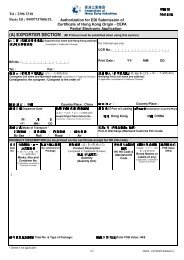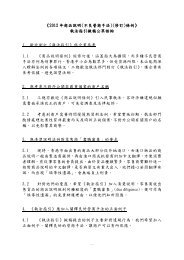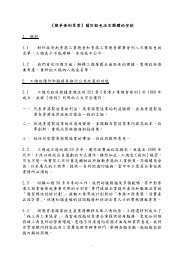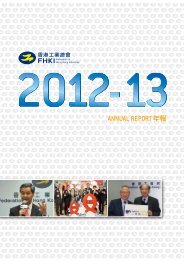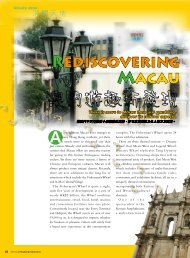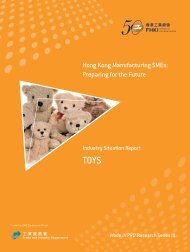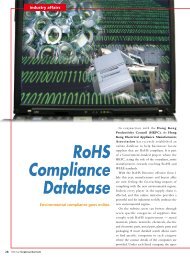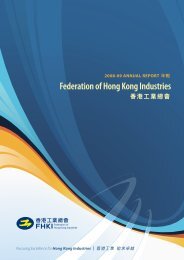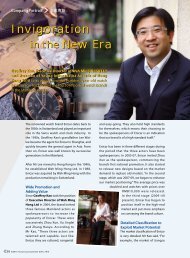24Competitive EnvironmentThe competitive environment <strong>for</strong> <strong>Hong</strong> <strong>Kong</strong>manufacturing <strong>SMEs</strong> in <strong>the</strong> PRD is changing inseveral ways. <strong>Hong</strong> <strong>Kong</strong> manufacturing firmsoperating in <strong>the</strong> PRD face increasing competitionfrom Mainland companies, ei<strong>the</strong>r within <strong>the</strong> PRDor in o<strong>the</strong>r regions of China, such as <strong>the</strong> YRD,Shandong province, and o<strong>the</strong>r areas that are tryingto attract manufacturing companies. 55For <strong>the</strong> past 30 years, <strong>Hong</strong> <strong>Kong</strong> firms havetransferred <strong>the</strong> factories, management practices,culture, skills, and connections to China and havehelped companies and managers in Mainland Chinato improve <strong>the</strong>ir capabilities in communicationand <strong>the</strong>ir quality assurance systems. In addition,increasingly Chinese firms are hiring employeesfrom <strong>Hong</strong> <strong>Kong</strong> firms as well as consultantsfrom Singapore firms, Korean firms, and o<strong>the</strong>rfirms where <strong>the</strong>y think that this will support <strong>the</strong>development of <strong>the</strong>ir business. 56 As a result, <strong>the</strong>gap between <strong>Hong</strong> <strong>Kong</strong> firms and Chinese firmshas become smaller and Chinese firms are lesswilling to play a junior role to <strong>Hong</strong> <strong>Kong</strong> businessinterests. 57Many Mainland Chinese companiesthat once were partners or contractors to <strong>Hong</strong><strong>Kong</strong> firms now have <strong>the</strong> skills, <strong>the</strong> technology, <strong>the</strong>capital, <strong>the</strong> critical industry mass, <strong>the</strong> supply chain,<strong>the</strong> domestic market, <strong>the</strong> know-how, <strong>the</strong> contacts,and <strong>the</strong> government support to go it on <strong>the</strong>ir own.Consequently, <strong>the</strong> main competitors of many <strong>Hong</strong><strong>Kong</strong> firms are Chinese companies, usually <strong>the</strong> spinoffsfounded by Chinese managers once hired andtrained by <strong>the</strong> <strong>Hong</strong> <strong>Kong</strong> companies. 58 It is difficult<strong>for</strong> <strong>Hong</strong> <strong>Kong</strong> <strong>SMEs</strong> to avoid this phenomenon.55 ESA Project Interview, 2010-03-25.56 ESA Project Interview, 2010-04-09.57 ESA Project Interview, 2010-04-09.58 ESA Project Interview, 2010-04-07.59 ESA Project Interview, 2010-04-07.60 ESA Project Interview, 2010-04-07.61 ESA Project Interviews, 2010-04-07, 2010-04-09.62 ESA Project Interview, 2010-03-26.Since fewer <strong>Hong</strong> <strong>Kong</strong> people are interested ingoing into manufacturing, <strong>the</strong> <strong>Hong</strong> <strong>Kong</strong> firmsoften have to hire Mainlanders <strong>for</strong> managementpositions even if this practice can eventually createcompetitors. In addition, many <strong>Hong</strong> <strong>Kong</strong> firms setup supply or subcontractor relations with Mainlandfirms and this too can create competitors.To <strong>the</strong> extent that Mainland competitors are ableto run a less expensive operation than <strong>the</strong>ir <strong>Hong</strong><strong>Kong</strong> counterparts, <strong>the</strong>y can quote lower prices andwin business from <strong>Hong</strong> <strong>Kong</strong> companies. The costdifferentials are such that if <strong>Hong</strong> <strong>Kong</strong> companieshave even a few <strong>Hong</strong> <strong>Kong</strong> staff <strong>the</strong>n this canalready provide a cost disadvantage that makesit difficult <strong>for</strong> <strong>the</strong> <strong>Hong</strong> <strong>Kong</strong> firms to competeagainst Mainland counterparts. 59<strong>Hong</strong> <strong>Kong</strong> manufacturing company managersinterviewed <strong>for</strong> this project indicated that Chinesefirms were viewed as being more competitivebecause of <strong>the</strong>ir ability to skirt <strong>the</strong> law withoutincurring penalties. According to <strong>the</strong> <strong>Hong</strong> <strong>Kong</strong>managers, <strong>Hong</strong> <strong>Kong</strong> companies need to follow<strong>the</strong> letter of <strong>the</strong> law and operate in a moreethical manner. As a result, some <strong>Hong</strong> <strong>Kong</strong>firms have seen <strong>the</strong>ir profit margins eroded in <strong>the</strong>face of competition from Mainland companiesthat are viewed as not having to meet <strong>the</strong> samemanufacturing and business standards. 60Interviewees also indicated that Mainlandcompanies are often more <strong>for</strong>ward-looking andaggressive than <strong>the</strong>ir <strong>Hong</strong> <strong>Kong</strong> counterparts.They are more likely to take risks and <strong>the</strong>y alsohave more local resources in <strong>the</strong> <strong>for</strong>m of local banksupport, “free capital,” or government support. 61Several interviewees <strong>for</strong> <strong>the</strong> present study indicatedthat indigenous Chinese firms learn very fastto “play <strong>the</strong> game,” making <strong>the</strong>m <strong>for</strong>midablecompetitors. 62 Mainland company owners are seenas being increasingly knowledgeable and capable,close to <strong>the</strong> ground, and closer to local officials.They are also often willing to put up with very lowmanufacturing margins, and will engage in practicessuch as copying <strong>the</strong> designs of o<strong>the</strong>r companies to
25keep costs down ra<strong>the</strong>r than investing in developing<strong>the</strong>ir own designs. On <strong>the</strong> o<strong>the</strong>r hand, intervieweesviewed <strong>Hong</strong> <strong>Kong</strong> firms and <strong>Hong</strong> <strong>Kong</strong> managersas more conservative and less connected. Forinstance, <strong>the</strong> senior management of <strong>Hong</strong> <strong>Kong</strong>firms tend to live in <strong>Hong</strong> <strong>Kong</strong> ra<strong>the</strong>r thanMainland China and <strong>the</strong>y do not commit sufficientlyto learning about China to maximise <strong>the</strong>ir abilityto leverage Chinese manufacturing or develop <strong>the</strong>China market. 63Chinese Mainland Policies AffectingOperations in <strong>the</strong> Pearl River DeltaEconomic and industrial policies within <strong>the</strong> ChineseMainland, particularly those focused on GuangdongProvince and <strong>the</strong> Pearl River Delta, have a criticalimpact on <strong>Hong</strong> <strong>Kong</strong> manufacturing <strong>SMEs</strong>. Ofparticular note have been policies <strong>for</strong> economicrestructuring in <strong>the</strong> PRD, <strong>the</strong> NDRC Plan <strong>for</strong> <strong>the</strong>Re<strong>for</strong>m and Development of <strong>the</strong> Pearl River Delta,and <strong>the</strong> <strong>Hong</strong> <strong>Kong</strong>-Guangdong CooperationFramework Agreement.Policies <strong>for</strong> Economic Restructuring in <strong>the</strong> PearlRiver DeltaEconomic policies and plans <strong>for</strong> <strong>the</strong> Pearl RiverDelta will have a dramatic impact on <strong>Hong</strong> <strong>Kong</strong>manufacturing <strong>SMEs</strong> that operate in <strong>the</strong> region.China’s 11 th Five Year Programme (2006-2010)reflected <strong>the</strong> Central Government’s view that<strong>the</strong> nation’s development needed to be adjustedto emphasise <strong>the</strong> quality of growth, reduceregional imbalances, reduce speculation in <strong>the</strong>property market, improve <strong>the</strong> environment, reducedependence on low value-added production, andimprove <strong>the</strong> position of workers. GuangdongProvince and <strong>the</strong> Pearl River Delta region werechosen to play a leading role in innovation,knowledge, and creativity-based economicdevelopment in China. This national role includedchannelling technology, funds, and know-how intoChina’s interior; acting as a base <strong>for</strong> <strong>for</strong>eign privateinvestment into China’s interior; and fostering <strong>the</strong>development of modern service sectors on par withthose found in advanced economies.Ano<strong>the</strong>r goal was to move labour-intensive, lowvalue-added, and/or polluting industries out of <strong>the</strong>inner areas of <strong>the</strong> Pearl River Delta into o<strong>the</strong>r partsof <strong>the</strong> region, o<strong>the</strong>r parts of Guangdong, or o<strong>the</strong>rparts of <strong>the</strong> country. One sign of how seriously <strong>the</strong>new directions have been taken is <strong>the</strong> fact that <strong>the</strong>Central Government has designated specific citiesin interior provinces that it hopes will become <strong>the</strong>homes of some of <strong>the</strong> industries moved out of<strong>the</strong> Pearl River Delta (and Yangtze River Delta aswell). These include Chenzhou (in Hunan Province),Wuhan (Hubei), Xinxiang and Jiaozuo (Henan), Hefeiand Wuhu (Anhui), Taiyuan (Shanxi), Nanchang andGanzhou (Jiangxi), and ano<strong>the</strong>r 22 cities.However, in <strong>the</strong> newly published policies by <strong>the</strong>State Council on using <strong>for</strong>eign capital, 64 highlypolluting, high energy-consumption, and resourceintensiveprojects, as well as projects in industriesrunning at overcapacity, will be strictly restrained allover China. Foreign-funded enterprises are offeredincome tax breaks to increase <strong>the</strong>ir investment inChina’s central and western regions, particularly ineco-friendly and labour-intensive companies.63 ESA Project Interview, 2010-04-07.64 Several Opinions of <strong>the</strong> State Council on Fur<strong>the</strong>r Fulfilling <strong>the</strong>Work of Using Foreign Capital (Guo fa [2010] no. 9), 6 April2010.



